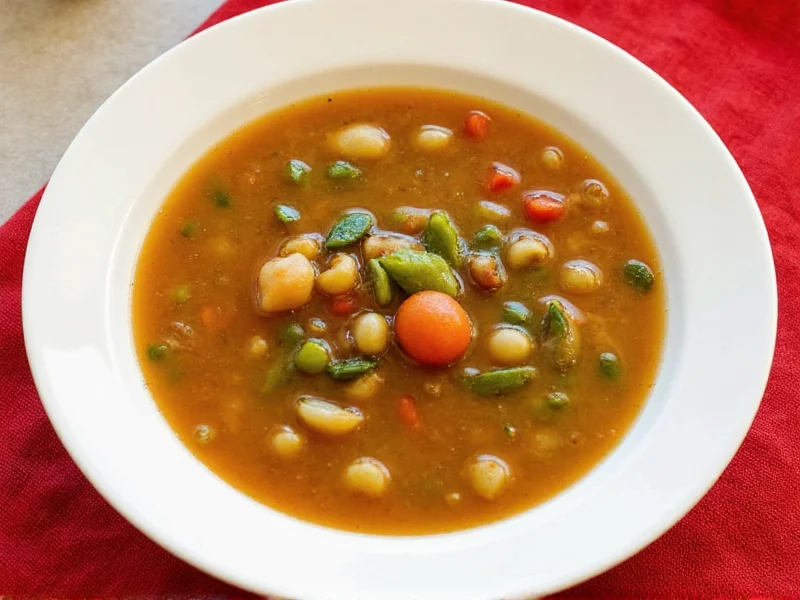Creating a satisfying crockpot vegetable soup requires understanding the balance between ingredient selection, cooking time, and flavor development. Unlike stovetop methods, slow cooking allows flavors to meld beautifully while preserving vegetable texture when done correctly. This comprehensive guide provides everything you need for perfect results every time.
Why Crockpot Vegetable Soup Excels
Slow cooking vegetable soup offers distinct advantages over traditional methods. The gentle, consistent heat of a crockpot extracts maximum flavor from vegetables while maintaining their integrity. Unlike boiling, which can make vegetables mushy, the low temperature preserves texture while allowing tough fibers to soften gradually. This easy crockpot vegetable soup recipe requires minimal hands-on time yet delivers restaurant-quality results.
Essential Ingredients for Flavorful Results
The foundation of exceptional vegetarian crockpot vegetable soup starts with quality ingredients:
- Aromatic base: Yellow onion, garlic, and celery (the "holy trinity" of soup making)
- Hearty vegetables: Carrots, potatoes, and parsnips for substance
- Tender vegetables: Zucchini, green beans, or bell peppers added later
- Flavor enhancers: Tomato paste, dried thyme, and bay leaves
- Liquid base: 6 cups low-sodium vegetable or chicken broth
For the best vegetables for slow cooker soup, choose firm varieties that hold their shape. Avoid adding delicate greens until the final hour to prevent overcooking.
Step-by-Step Preparation Guide
Follow these steps for foolproof crockpot vegetable soup with broth that develops deep flavors:
- Sauté onions, garlic, and celery in olive oil until softened (5-7 minutes)
- Add tomato paste and cook for 1 minute to deepen flavor
- Transfer to crockpot with potatoes, carrots, broth, and herbs
- Cook on low for 5 hours
- Add tender vegetables and cook 1-2 hours more
- Season with salt, pepper, and fresh parsley before serving
| Cooking Setting | Time Required | Best For |
|---|---|---|
| Low | 6-8 hours | Maximum flavor development, hands-off cooking |
| High | 3-4 hours | When short on time, but slightly less developed flavors |
| Warm | Up to 2 hours | Holding finished soup before serving |
Perfecting Your Crockpot Vegetable Soup
Achieving restaurant-quality results with your flavorful vegetable soup slow cooker requires attention to these critical details:
Timing is Everything
Understanding how long to cook vegetable soup in crockpot prevents mushy vegetables. Root vegetables need the full cooking time, while delicate ingredients like peas or spinach should go in during the last 30-60 minutes. Overcooking turns vegetables to mush, while undercooking leaves them too firm.
Flavor Building Techniques
For deeper flavor in your healthy crockpot vegetable soup, try these professional techniques:
- Brown tomato paste before adding to develop richer flavor
- Add a Parmesan rind during cooking for umami depth (remove before serving)
- Finish with a splash of acid (lemon juice or vinegar) to brighten flavors
- Stir in fresh herbs just before serving for vibrant flavor
Avoiding Common Mistakes
Prevent these frequent errors when making crockpot vegetable soup for meal prep:
- Don't add too much liquid initially - vegetables release water as they cook
- Avoid excessive salt early in cooking - flavors concentrate as liquid reduces
- Don't overfill the crockpot - leave at least 1/2 space at the top for proper heat circulation
- Resist frequent lid lifting - each time you peek, you lose 20 minutes of cooking time
Variations to Suit Any Preference
Customize your vegetarian crockpot vegetable soup with these popular adaptations:
- Protein boost: Add white beans or lentils during the last 2 hours
- Creamy version: Stir in coconut milk or cream during the last 30 minutes
- Hearty minestrone: Include pasta or barley during the final hour
- Spicy kick: Add red pepper flakes or a dash of hot sauce before serving
Storage and Reheating Guidelines
Proper handling ensures your leftover crockpot vegetable soup storage maintains quality:
- Cool soup within 2 hours of cooking
- Store in airtight containers for up to 5 days in the refrigerator
- Freeze in portion-sized containers for up to 3 months
- Reheat gently on stove or in microwave, adding broth if too thick
For optimal texture when reheating, add delicate vegetables fresh rather than storing them in the soup.
Nutritional Benefits
A well-constructed healthy crockpot vegetable soup delivers significant nutritional advantages. The slow cooking process preserves more nutrients than boiling, while the combination of various colored vegetables provides a spectrum of vitamins, minerals, and antioxidants. This naturally low-calorie meal supports hydration and provides dietary fiber that aids digestion. The long cooking time breaks down vegetable fibers, making nutrients more bioavailable and easier to digest.
Thickening Techniques
If you prefer a heartier texture, consider these methods for thickening crockpot vegetable soup without compromising flavor:
- Create a slurry with cornstarch and cold water (1 tbsp cornstarch to 1 cup water)
- Blend a portion of the soup and return it to the pot
- Add a peeled, diced potato which releases natural starches
- Simmer uncovered for the final 30-60 minutes to reduce liquid
Each technique affects the final texture differently, so choose based on your preference for a brothy or stew-like consistency.











 浙公网安备
33010002000092号
浙公网安备
33010002000092号 浙B2-20120091-4
浙B2-20120091-4